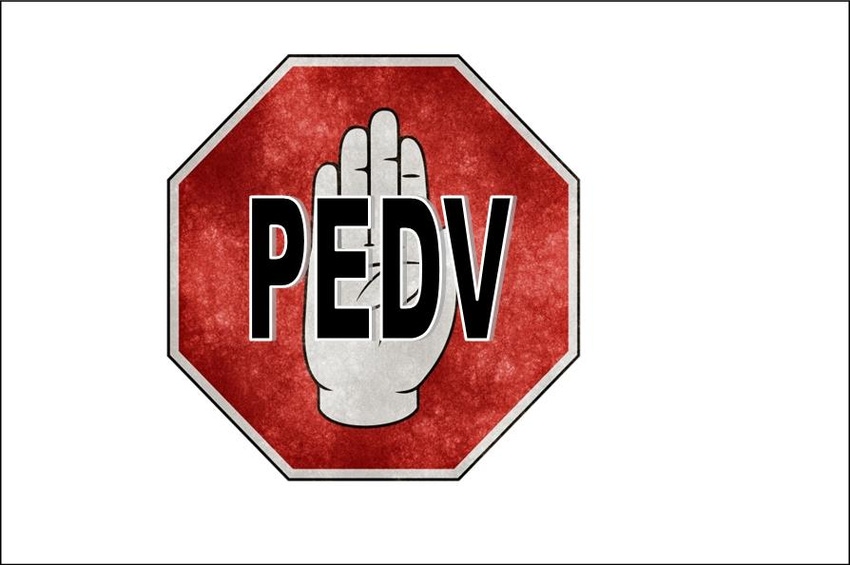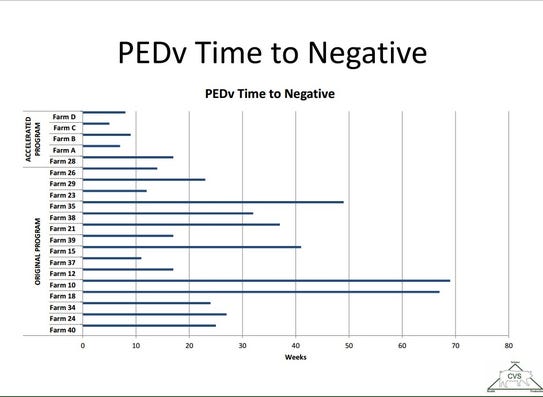Working toward PEDV elimination in 2016

Although the cases of porcine epidemic diarrhea virus have lessened quite a bit since its sudden emergence in the United States in 2013, Joseph Connor, DVM and president of Carthage Veterinary Service Ltd. at the 25th annual Swine Health and Production Conference advised hog farmers to stay vigilant against this production-limiting virus. Connor proposes the question to a room full of hog farmers: “Can we eliminate PEDV from North America in 2016?”.
Building on lessons learned, he shared an improved PEDV plan of action to more effectively manage the virus, reduce losses and hopefully eliminate it in the future. A year ago, the plan to manage PEDV� would have included exposing the entire sow herd and replacement gilts to the virus and intense sanitation. However, Connor explains that an accelerated swine enteric coronavirus stabilization procedure was developed to manage the disease in a tighter window and provide better results. This revised program is recommended for all three strains – PEDV1, PEDV2 and PDCoV.
Accelerated Swine Enteric Coronavirus Stabilization procedures
Connor says the first step is to close the herd. The herd should be closed for 12 to 18 weeks to new introductions. On Day Zero, all pigs should be weaned down to seven days of age and removed from the farm. The survivability rate of those pigs from eight to 10 days of age is still 70%, but still higher level than those pigs left on the infected sow, which is typically less than 10%.
The next step is a Planned Natural Exposure for all sows and replacement gilts on the farm. He advises to start with those sows less than six weeks prior to farrowing and replacement gilts 6 to 30 weeks of age.
Connor explains that the biggest change from the original PEDV control program is to remove all piglets for 14 days from initial planned outbreak. Also, pre-farrowing vaccinations should be initiated for replacement gilts.
On the last day of the PNE, an aggressive and concentrated sanitation program should begin in both gestation and farrowing facilities. Fully wash gestation barn by day 14 post-break.
In the farrowing barns, sanitation steps for Day 1:
Soak
Degrease
Hot water wash
Bleach or Virkon disinfect
Dry overnight
On Day 2:
White wash with lime
Dry
In addition, boot changes or disinfection boot washes between farrowing and gestation barns policies should be instituted. In the farrowing barns, all piglet mortalities should be retained in a bucket within the room. All hallways need to be washed, disinfected and dried immediately after each pig movement.
On Day 14 to 17 post-PNE, all inductions of sows due to farrow should be halted. Connor recommends using Altrenogest (Matrix) to extend gestation length to 117 days to reach the 21 days necessary to develop immunity.
For one turn of farrowing, all movement of pigs should be stopped. The McREBEL - Management Changes to Reduce Exposure to Bacteria and Eliminate Losses - procedure should be followed.
From a production standpoint, all sows with lactation lengths longer than seven days should be bred. Connor recommends skipping all sows for one estrus cycle with lactation lengths less than seven days.
Endemic herd plan
The Accelerated Swine Enteric Coronavirus Stabilization program can also be used in endemic herds to reach PEDV-negative status by starting with a natural planned exposure to the sow herd and at least 12 weeks of developing gilts. All pigs are humanely culled for 14 days. For those endemic herds that only the parity 1 litters cause the contagious diarrhea, then those P1 piglets should be segregated and removed. The same intense sanitation and pre-farrowing vaccination as previously discussed should also be followed.
Connor also offers an alternative plan for endemic herds.
Alternative 1
Remove and farrow P1 sows or block of sows at another facility
If scouring litters are all parities then remove piglets from all parities
Natural planned exposure to sow herd and gilts at least 12 weeks of age
Intense sanitation
Alternative 2
Segregate rooms
Bubble depopulation
Accelerated vs. original program
As shown in Figure 1, Connor says the length of time it took a herd to reach negative status was greatly shortened with the accelerated program.
Figure 1
For hog farms using the accelerated program it took five to 17 weeks compared to the original program that took 11 to 69 weeks (see Figure 2). Furthermore, he says a long-term reproduction drag was not observed after the accelerated program was implemented.
Figure 2
North America PEDV elimination
Moving into 2016, Connor challenges the U.S. pork industry to work together toward PEDV eradication grounded on the tremendous information already gathered on biosecurity, control measures to prevent reintroduction and utilizing the accelerated program.
In order to achieve PEDV elimination in North America, it must be led by hog producers. Aggressive diagnostic surveillance must continue for both incoming breeding stock and all weaned pig flows. Active sites in all stages of production must be identified. Positive sites need to follow herd programs to reach negative status. Stringent biosecurity must be maintained. Moreover, Connor also clearly states that the natural live virus exposure – after this winter- needs to be discontinued in order to eradicate the virus. Although research shows that natural live exposure is important to building immunity, it at some point becomes a risk.
In conclusion, Connor says, “We have the technology today to move forward with elimination of PEDV in 2016. We have to be very excited about the progress we have made.”
About the Author(s)
You May Also Like



